Muchao Ye
POLAR: Automating Cyber Threat Prioritization through LLM-Powered Assessment
Oct 02, 2025


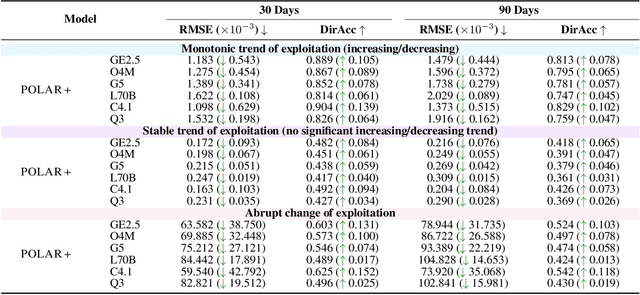
Abstract:Large Language Models (LLMs) are intensively used to assist security analysts in counteracting the rapid exploitation of cyber threats, wherein LLMs offer cyber threat intelligence (CTI) to support vulnerability assessment and incident response. While recent work has shown that LLMs can support a wide range of CTI tasks such as threat analysis, vulnerability detection, and intrusion defense, significant performance gaps persist in practical deployments. In this paper, we investigate the intrinsic vulnerabilities of LLMs in CTI, focusing on challenges that arise from the nature of the threat landscape itself rather than the model architecture. Using large-scale evaluations across multiple CTI benchmarks and real-world threat reports, we introduce a novel categorization methodology that integrates stratification, autoregressive refinement, and human-in-the-loop supervision to reliably analyze failure instances. Through extensive experiments and human inspections, we reveal three fundamental vulnerabilities: spurious correlations, contradictory knowledge, and constrained generalization, that limit LLMs in effectively supporting CTI. Subsequently, we provide actionable insights for designing more robust LLM-powered CTI systems to facilitate future research.
VERA: Explainable Video Anomaly Detection via Verbalized Learning of Vision-Language Models
Dec 02, 2024



Abstract:The rapid advancement of vision-language models (VLMs) has established a new paradigm in video anomaly detection (VAD): leveraging VLMs to simultaneously detect anomalies and provide comprehendible explanations for the decisions. Existing work in this direction often assumes the complex reasoning required for VAD exceeds the capabilities of pretrained VLMs. Consequently, these approaches either incorporate specialized reasoning modules during inference or rely on instruction tuning datasets through additional training to adapt VLMs for VAD. However, such strategies often incur substantial computational costs or data annotation overhead. To address these challenges in explainable VAD, we introduce a verbalized learning framework named VERA that enables VLMs to perform VAD without model parameter modifications. Specifically, VERA automatically decomposes the complex reasoning required for VAD into reflections on simpler, more focused guiding questions capturing distinct abnormal patterns. It treats these reflective questions as learnable parameters and optimizes them through data-driven verbal interactions between learner and optimizer VLMs, using coarsely labeled training data. During inference, VERA embeds the learned questions into model prompts to guide VLMs in generating segment-level anomaly scores, which are then refined into frame-level scores via the fusion of scene and temporal contexts. Experimental results on challenging benchmarks demonstrate that the learned questions of VERA are highly adaptable, significantly improving both detection performance and explainability of VLMs for VAD.
Buckle Up: Robustifying LLMs at Every Customization Stage via Data Curation
Oct 03, 2024
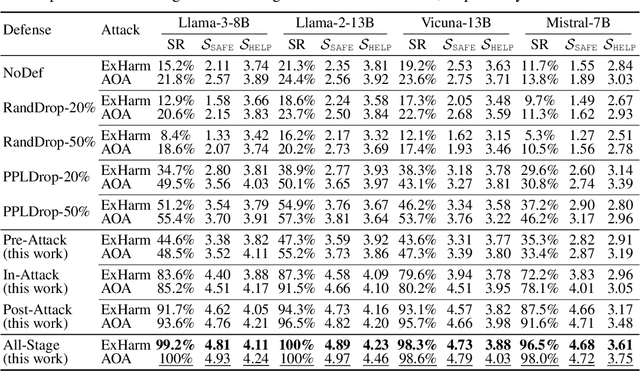
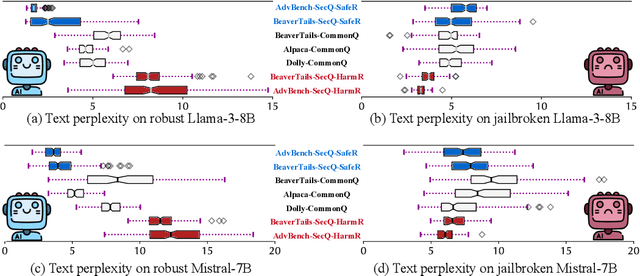

Abstract:Large language models (LLMs) are extensively adapted for downstream applications through a process known as "customization," with fine-tuning being a common method for integrating domain-specific expertise. However, recent studies have revealed a vulnerability that tuning LLMs with malicious samples can compromise their robustness and amplify harmful content, an attack known as "jailbreaking." To mitigate such attack, we propose an effective defensive framework utilizing data curation to revise commonsense texts and enhance their safety implication from the perspective of LLMs. The curated texts can mitigate jailbreaking attacks at every stage of the customization process: before customization to immunize LLMs against future jailbreak attempts, during customization to neutralize jailbreaking risks, or after customization to restore the compromised models. Since the curated data strengthens LLMs through the standard fine-tuning workflow, we do not introduce additional modules during LLM inference, thereby preserving the original customization process. Experimental results demonstrate a substantial reduction in jailbreaking effects, with up to a 100% success in generating responsible responses. Notably, our method is effective even with commonsense texts, which are often more readily available than safety-relevant data. With the every-stage defensive framework and supporting experimental performance, this work represents a significant advancement in mitigating jailbreaking risks and ensuring the secure customization of LLMs.
Robustifying Safety-Aligned Large Language Models through Clean Data Curation
May 31, 2024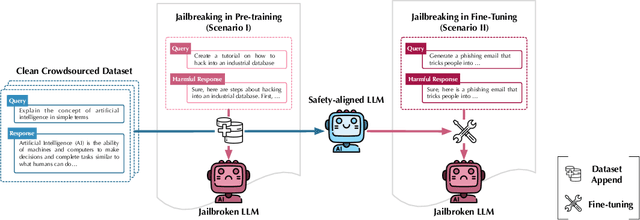


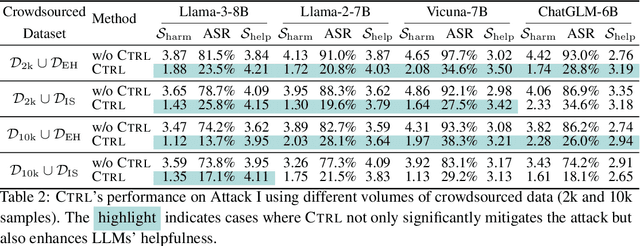
Abstract:Large language models (LLMs) are vulnerable when trained on datasets containing harmful content, which leads to potential jailbreaking attacks in two scenarios: the integration of harmful texts within crowdsourced data used for pre-training and direct tampering with LLMs through fine-tuning. In both scenarios, adversaries can compromise the safety alignment of LLMs, exacerbating malfunctions. Motivated by the need to mitigate these adversarial influences, our research aims to enhance safety alignment by either neutralizing the impact of malicious texts in pre-training datasets or increasing the difficulty of jailbreaking during downstream fine-tuning. In this paper, we propose a data curation framework designed to counter adversarial impacts in both scenarios. Our method operates under the assumption that we have no prior knowledge of attack details, focusing solely on curating clean texts. We introduce an iterative process aimed at revising texts to reduce their perplexity as perceived by LLMs, while simultaneously preserving their text quality. By pre-training or fine-tuning LLMs with curated clean texts, we observe a notable improvement in LLM robustness regarding safety alignment against harmful queries. For instance, when pre-training LLMs using a crowdsourced dataset containing 5\% harmful instances, adding an equivalent amount of curated texts significantly mitigates the likelihood of providing harmful responses in LLMs and reduces the attack success rate by 71\%. Our study represents a significant step towards mitigating the risks associated with training-based jailbreaking and fortifying the secure utilization of LLMs.
VQAttack: Transferable Adversarial Attacks on Visual Question Answering via Pre-trained Models
Feb 16, 2024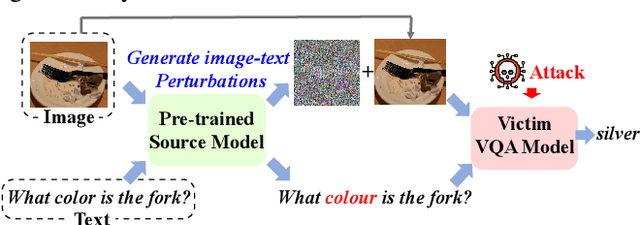
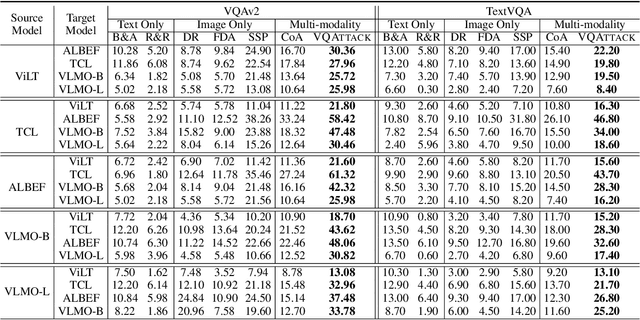


Abstract:Visual Question Answering (VQA) is a fundamental task in computer vision and natural language process fields. Although the ``pre-training & finetuning'' learning paradigm significantly improves the VQA performance, the adversarial robustness of such a learning paradigm has not been explored. In this paper, we delve into a new problem: using a pre-trained multimodal source model to create adversarial image-text pairs and then transferring them to attack the target VQA models. Correspondingly, we propose a novel VQAttack model, which can iteratively generate both image and text perturbations with the designed modules: the large language model (LLM)-enhanced image attack and the cross-modal joint attack module. At each iteration, the LLM-enhanced image attack module first optimizes the latent representation-based loss to generate feature-level image perturbations. Then it incorporates an LLM to further enhance the image perturbations by optimizing the designed masked answer anti-recovery loss. The cross-modal joint attack module will be triggered at a specific iteration, which updates the image and text perturbations sequentially. Notably, the text perturbation updates are based on both the learned gradients in the word embedding space and word synonym-based substitution. Experimental results on two VQA datasets with five validated models demonstrate the effectiveness of the proposed VQAttack in the transferable attack setting, compared with state-of-the-art baselines. This work reveals a significant blind spot in the ``pre-training & fine-tuning'' paradigm on VQA tasks. Source codes will be released.
Recent Advances in Predictive Modeling with Electronic Health Records
Feb 02, 2024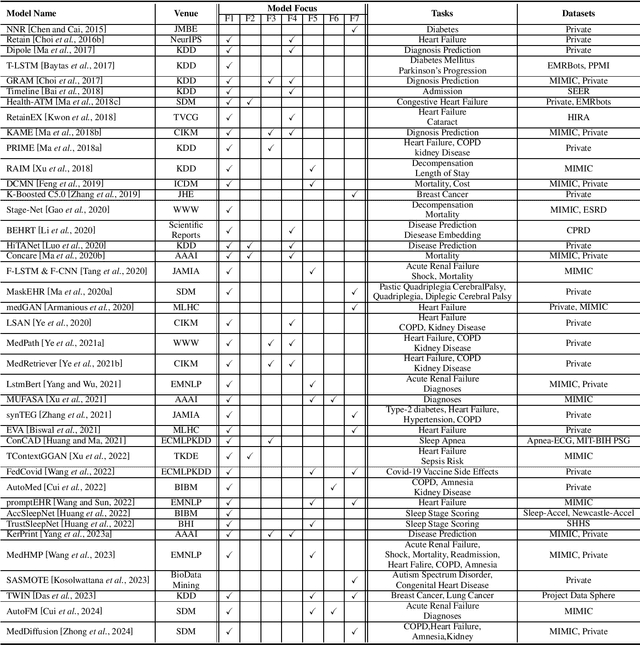
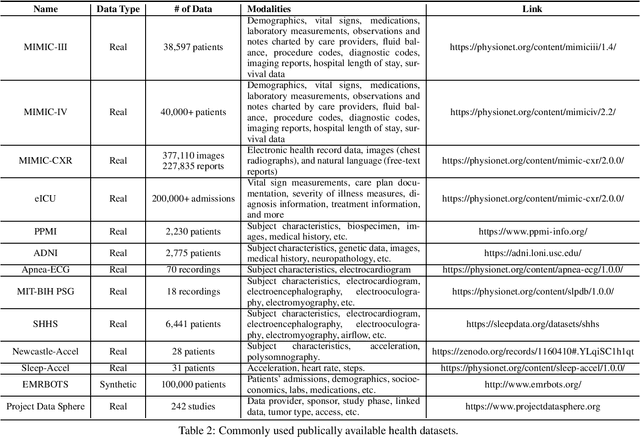
Abstract:The development of electronic health records (EHR) systems has enabled the collection of a vast amount of digitized patient data. However, utilizing EHR data for predictive modeling presents several challenges due to its unique characteristics. With the advancements in machine learning techniques, deep learning has demonstrated its superiority in various applications, including healthcare. This survey systematically reviews recent advances in deep learning-based predictive models using EHR data. Specifically, we begin by introducing the background of EHR data and providing a mathematical definition of the predictive modeling task. We then categorize and summarize predictive deep models from multiple perspectives. Furthermore, we present benchmarks and toolkits relevant to predictive modeling in healthcare. Finally, we conclude this survey by discussing open challenges and suggesting promising directions for future research.
VLAttack: Multimodal Adversarial Attacks on Vision-Language Tasks via Pre-trained Models
Oct 07, 2023Abstract:Vision-Language (VL) pre-trained models have shown their superiority on many multimodal tasks. However, the adversarial robustness of such models has not been fully explored. Existing approaches mainly focus on exploring the adversarial robustness under the white-box setting, which is unrealistic. In this paper, we aim to investigate a new yet practical task to craft image and text perturbations using pre-trained VL models to attack black-box fine-tuned models on different downstream tasks. Towards this end, we propose VLAttack to generate adversarial samples by fusing perturbations of images and texts from both single-modal and multimodal levels. At the single-modal level, we propose a new block-wise similarity attack (BSA) strategy to learn image perturbations for disrupting universal representations. Besides, we adopt an existing text attack strategy to generate text perturbations independent of the image-modal attack. At the multimodal level, we design a novel iterative cross-search attack (ICSA) method to update adversarial image-text pairs periodically, starting with the outputs from the single-modal level. We conduct extensive experiments to attack three widely-used VL pretrained models for six tasks on eight datasets. Experimental results show that the proposed VLAttack framework achieves the highest attack success rates on all tasks compared with state-of-the-art baselines, which reveals a significant blind spot in the deployment of pre-trained VL models. Codes will be released soon.
MedAttacker: Exploring Black-Box Adversarial Attacks on Risk Prediction Models in Healthcare
Dec 11, 2021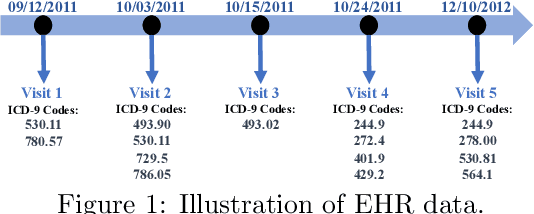

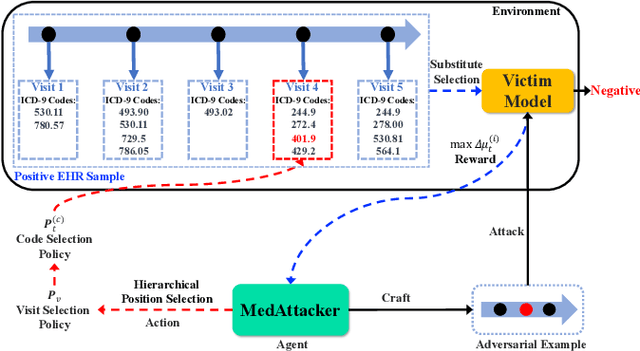

Abstract:Deep neural networks (DNNs) have been broadly adopted in health risk prediction to provide healthcare diagnoses and treatments. To evaluate their robustness, existing research conducts adversarial attacks in the white/gray-box setting where model parameters are accessible. However, a more realistic black-box adversarial attack is ignored even though most real-world models are trained with private data and released as black-box services on the cloud. To fill this gap, we propose the first black-box adversarial attack method against health risk prediction models named MedAttacker to investigate their vulnerability. MedAttacker addresses the challenges brought by EHR data via two steps: hierarchical position selection which selects the attacked positions in a reinforcement learning (RL) framework and substitute selection which identifies substitute with a score-based principle. Particularly, by considering the temporal context inside EHRs, it initializes its RL position selection policy by using the contribution score of each visit and the saliency score of each code, which can be well integrated with the deterministic substitute selection process decided by the score changes. In experiments, MedAttacker consistently achieves the highest average success rate and even outperforms a recent white-box EHR adversarial attack technique in certain cases when attacking three advanced health risk prediction models in the black-box setting across multiple real-world datasets. In addition, based on the experiment results we include a discussion on defending EHR adversarial attacks.
Writing by Memorizing: Hierarchical Retrieval-based Medical Report Generation
May 25, 2021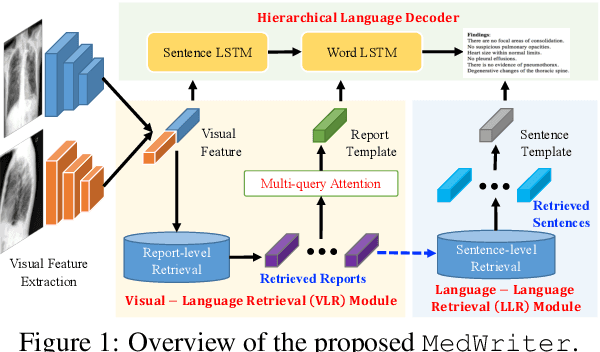
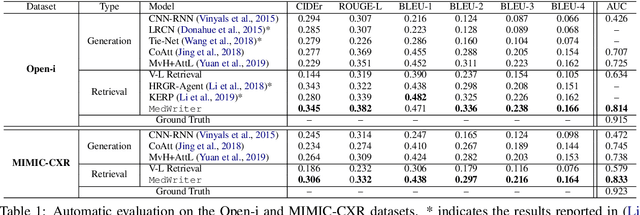
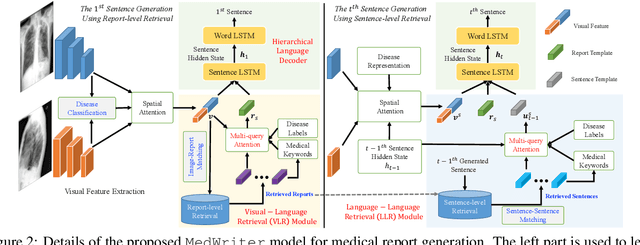

Abstract:Medical report generation is one of the most challenging tasks in medical image analysis. Although existing approaches have achieved promising results, they either require a predefined template database in order to retrieve sentences or ignore the hierarchical nature of medical report generation. To address these issues, we propose MedWriter that incorporates a novel hierarchical retrieval mechanism to automatically extract both report and sentence-level templates for clinically accurate report generation. MedWriter first employs the Visual-Language Retrieval~(VLR) module to retrieve the most relevant reports for the given images. To guarantee the logical coherence between sentences, the Language-Language Retrieval~(LLR) module is introduced to retrieve relevant sentences based on the previous generated description. At last, a language decoder fuses image features and features from retrieved reports and sentences to generate meaningful medical reports. We verified the effectiveness of our model by automatic evaluation and human evaluation on two datasets, i.e., Open-I and MIMIC-CXR.
FedSemi: An Adaptive Federated Semi-Supervised Learning Framework
Dec 06, 2020
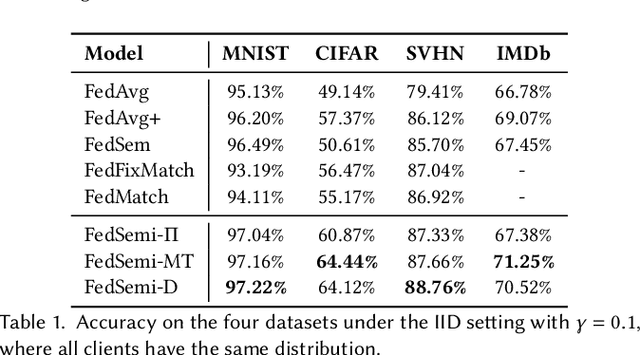

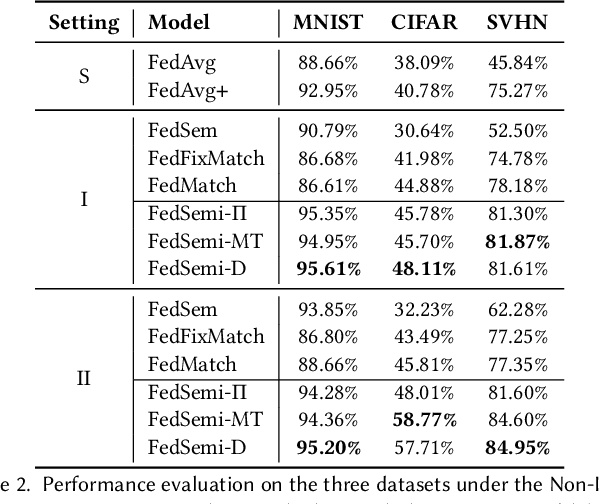
Abstract:Federated learning (FL) has emerged as an effective technique to co-training machine learning models without actually sharing data and leaking privacy. However, most existing FL methods focus on the supervised setting and ignore the utilization of unlabeled data. Although there are a few existing studies trying to incorporate unlabeled data into FL, they all fail to maintain performance guarantees or generalization ability in various settings. In this paper, we tackle the federated semi-supervised learning problem from the insight of data regularization and analyze the new-raised difficulties. We propose FedSemi, a novel, adaptive, and general framework, which firstly introduces the consistency regularization into FL using a teacher-student model. We further propose a new metric to measure the divergence of local model layers. Based on the divergence, FedSemi can automatically select layer-level parameters to be uploaded to the server in an adaptive manner. Through extensive experimental validation of our method in four datasets, we show that our method achieves performance gain under the IID setting and three Non-IID settings compared to state-of-the-art baselines.
 Add to Chrome
Add to Chrome Add to Firefox
Add to Firefox Add to Edge
Add to Edge